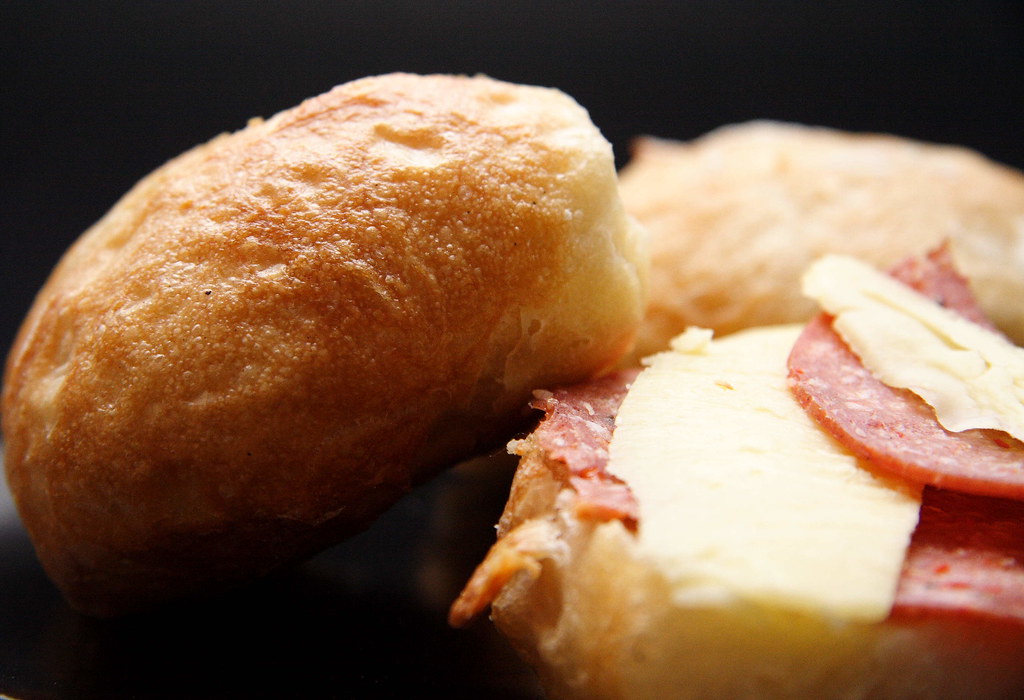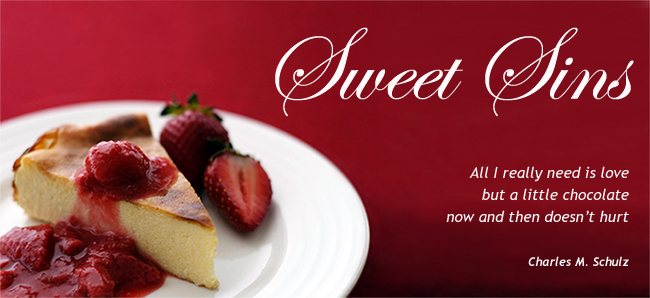
This years World Day of Bread on 16th October has been a complete success. Zorra of Kochtopf the creator of this blog event had to be really busy: check out her round-up of 184 entries with more than 200 bread recipes from 28 different countries!
And it looks like that this streak of bad bread baking luck has finally left me. Since then, I've been able to make the crusty bread rolls pictured above which was quite a miracle in itself. I started off with a recipe by Peter Reinhart and realized mid-way through that I didn't have certain ingredient. So I switched to a Rose Levy Beranbaum recipe - all the way ignoring the difference between dry active yeast (that's what I have at home) and instant yeast (that's what these guys are using). Luckily, I noticed it early enough and could adjust fermenting and rising times accordingly...
 For the ones who were interested in a traditional German-style cheese cake, I've finally managed to inquire about the recipe (after baking I had simply forgot to jot it down). Over the years, I've tried many a recipe for this kind of cake which is one of the most popular in Germany. I've also gotten very good results using a few tablespoons of semolina as a stabilizer but the following recipe is the favourite of my family.
For the ones who were interested in a traditional German-style cheese cake, I've finally managed to inquire about the recipe (after baking I had simply forgot to jot it down). Over the years, I've tried many a recipe for this kind of cake which is one of the most popular in Germany. I've also gotten very good results using a few tablespoons of semolina as a stabilizer but the following recipe is the favourite of my family.Usually, the recipe calls for rum-soaked raisins which also act as a stabilizer. However, this time we had run out of them - but I'm not fond of raisins anyway. That means, most of the time, two cakes have to be baked to make everyone happy..;-)
Shortcrust Pastry
The ingredients
150g butter, softened
100g sugar
pinch of salt
1 egg
1 sachet vanilla sugar (equals a heaped tablespoon)
1-2 tbsp rum
250g all-purpose flour
1/2 sachet baking powder (equals 7.5g)
1
Cream butter with both types of sugar and the salt until pale and fluffy.
2
Incorporate the egg and the rum, mixing thoroughly.
3
Add flour and baking powder mixing on low speed until it all comes together.
4
Take the dough out of the mixing bowl and briefly knead together. Shape into a ball, cover with foil and chill in the fridge until ready to use (at least 30 minutes).
The hint
This dough will be softer than shortcrust pastry that is made by cutting the butter into the flour. However, it should not be sticky. Don't add anymore flour otherwise you'll end up with concrete and not with a tender crust.
The filling
The ingredients
(suitable for a springform 28 centimetres in diameter)
60g butter, softened
200g sugar
2 sachets vanilla sugar
pinch of salt
4 eggs, separated
1 kg quark (can be substituted with ricotta)
50g all-purpose flour
1/2 sachet baking poweder (7.5g)
If using a springform of 26 centimetres, only change the following amounts:
50g butter
150g sugar
3 eggs, separated
1 sachet vanilla sugar
750g quark
(the amounts for flour and baking powder stay the same)
1
In a dry, fat-free bowl, beat the egg whites with the salt until stiff peaks form. Set aside.
2
In another big bowl, cream butter with both types of sugar.
3
Mix in egg yolks until thoroughly incorporated.
4
Mix in quark. To make sure that everything is evenly distributed, use a spatula to scrape down sides and bottom.
5
Scrape egg whites on top of quark mixture, sift flour and baking powder atop. Gently fold everything together.
6
Butter your preferred springform pan and line it with the shortcrust pastry. I usually don't roll it but rather tear off pieces and press them into the tin. I make the rim by rolling pastry into little rolls and pressing them onto the sides of the tin.
7
Pour in the filling and fan-bake at 150 degrees Celsius for up to an hour or until well-set. The crust should be golden-brown and the filling should be speckled with brownish dots.
The hint
After turning off the oven, let the cake rest in there for at least another hour. That way, the quark filling won't collapse as much.


19 comments:
that is indeed the most perfect looking cheesecake, not to mention the wonderfully constructed photograph.
im keen to try this recipe. will be my first time trying something german!
Thank you, Tytty! I hope you'll get as hooked on it as I am once you've tried for the first time..;-)
Finally, You posted Käse kuchen. I love it very much. Thanks for sharing the recipe. I´ll try it!
Let me know how you go, Retno!
Freut mich zu lesen, dass der Brotgott wieder auf deiner Seite ist. ;-)
Hi Eva, your cheesecake recipe sounds wonderful. Next time I get a request for cheesecake, I will try this recipe (with raisins!). Thanks also for the tip for a smaller pan.
p/s: it's good to hear that your bread baking "curse" is over. ;-) I actually find that hard to believe that you had such bad luck because you are the bread guru!
Eva, what a fantastic cake! I would love to try it! yum...
And i re-activated my starter, no prob. But no time to bake any sourdough yet so back to the fridge it goes. Did you freeze your starter? i just kept mine in the fridge for a few months, and it seems to work just fine.
Oh, yummy! I love that! We also make the same cheesecake here in Switzerland (Quarktorte), but we add some raisins to the quark filling...
Cheers,
Rosa
Es wurde auch wirklich Zeit, Zorra! Hab schon angefangen, an mir zu zweifeln...
Nora - I thought I had gotten the hang of it but now I know that one should have a very humble approach to such a sometimes tricky business. You never know what these little bacterias are up to..;-)
Regarding the cheese cake, to have the real experience it would be worth getting the real quark (ricotta just doesn't cut it). I'm curious to see if you like cos it's really different!
Anh - You'll see that this cheesecake is dangerous! It tastes so light and fluffy (compared to regular cheesecake) that you'll find yourself reaching for another slice, and another..;-)
I usually freeze my sourdough culture when I'm going away for several weeks but maybe I should try your way. Seems more reliable!
Rosa - It must be common throughout German-speaking countries, I think the Austrians have it, too. Oh, you could have it every week, I envy you a little bit!
That is the most perfect looking lice i've seen. i even like your idea abt the semolina to stabilize it. I made cheesecake last and my center was a bit squidgy , so the slice was not perfect , but this one ...its perfect :D!
What a nice compliment, thanks Kate! I've eaten more than my fair share of cheesecakes so far - I'm glad to hear that this indulgence is worth something..;-)
Looks so inviting, sure taste a winner!
The German CC recipe sounds wonderful...Thank you for sharing
Where do I get the real quark???? David Jones food hall?
Big Boys Oven - Let me assure you, this cake won't disappoint!
Andamalin - Thanks for stopping by, I hope you'll give it a shot!
Nora - Yes, that's the only place I know for sure where you can get it. However, you have to be prepared to shell out up to 6 bucks for 250g! When I saw this, my cheese cake cravings suddenly stopped... Two other things I haven't tried yet is looking at Greek delis (at least I think that Greek people also eat quark) and you could try making wanna-be quark:
In a big sieve or colander, lined with cheese cloth, put about 1kg of yoghurt. Let drain until the weight is reduced by half. Then the texture should resemble quark (and the taste, too). I haven't found cheese cloth yet but absorbent gauze is said to work well, too. Guess I'll have to do a follow-up post and try this soon myself!
Eva, the bread looks so good and this cheesecake is totally new to me.
Thank you Patricia! I'd love to convert everyone to this kind of cheesecake..;-)
Hello, I've just found your blog and wanted to compliment its beauty! Lovely pictures.
Also, I am very curious to know what makes this cheesecake German. I'd love to prepare it for some German friends, but wanted to know the scoop first! Thanks, Robin
Hi Clumsy, thanks for the nice compliment! As for the cheesecake, the biggest difference to American-style cheesecakes is its fluffiness and the slightly tangy taste. This taste and the light texture are due to quark; the stiffly beaten egg whites enhance the fluffiness, too. Quark is also rather low in calories (and I think there's less sugar involved - so I try to tell myself that it's not that unhealthy when reaching for a second slice..;-)
Another big difference is that you have a short crust pastry base; cracker crusts are not common in Germany.
All in all, it's probably not just a German cheesecake but rather a specialty of German-speaking countries. I've never had a cake like this outside Germany/Austria/Switzerland.
Hope this helps!
Post a Comment